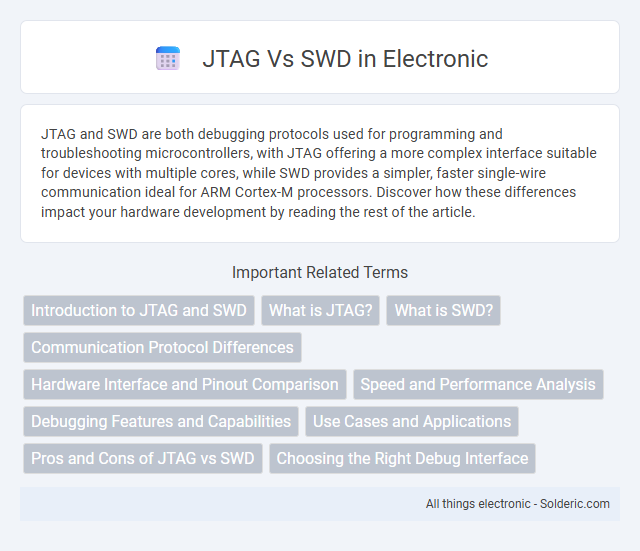JTAG and SWD are both debugging protocols used for programming and troubleshooting microcontrollers, with JTAG offering a more complex interface suitable for devices with multiple cores, while SWD provides a simpler, faster single-wire communication ideal for ARM Cortex-M processors. Discover how these differences impact your hardware development by reading the rest of the article.
Comparison Table
| Feature | JTAG (Joint Test Action Group) | SWD (Serial Wire Debug) |
|---|---|---|
| Interface Type | 4 or 5-wire parallel interface | 2-wire serial interface |
| Pin Count | Higher (typically 4-5 pins) | Lower (2 pins) |
| Data Transfer Rate | Moderate, depends on clock frequency | High, optimized for ARM Cortex microcontrollers |
| Supported Devices | Wide range of microcontrollers and FPGAs | Primarily ARM Cortex-M series microcontrollers |
| Debug Functionality | Full boundary scan, programming, debug | Debugging and programming with reduced pin count |
| Complexity | More complex due to multiple signals | Simple, uses fewer signals |
| Power Consumption | Higher due to multiple pins toggling | Lower power consumption |
| Industry Use | Standard for boundary scan testing and older microcontrollers | Preferred in modern ARM Cortex-M debugging |
Introduction to JTAG and SWD
JTAG (Joint Test Action Group) and SWD (Serial Wire Debug) are two primary debugging interfaces used in embedded systems for programming and testing microcontrollers. JTAG is a standardized 4- or 5-pin interface widely supported across various devices, offering extensive boundary-scan testing and debugging capabilities. SWD provides a more efficient 2-pin interface designed specifically for ARM Cortex processors, offering faster communication and reduced pin count without sacrificing debug functionality.
What is JTAG?
JTAG (Joint Test Action Group) is a standardized interface used for testing and programming embedded systems and microcontrollers through boundary-scan architecture. It enables communication with internal device components for debugging, programming, and diagnostics without requiring physical access to the chip's core. Commonly implemented in complex systems, JTAG supports multiple test access ports and is widely adopted for hardware validation and firmware development.
What is SWD?
SWD (Serial Wire Debug) is a two-pin interface designed for debugging and programming ARM Cortex microcontrollers, offering a compact alternative to the traditional JTAG (Joint Test Action Group) interface. It uses fewer pins, typically just SWDIO and SWCLK, reducing PCB complexity while maintaining efficient access to the processor's debug features. If you're working with ARM-based devices, SWD provides a streamlined debugging solution that supports breakpoints, watchpoints, and real-time data access.
Communication Protocol Differences
JTAG uses a multi-wire interface with at least four to five dedicated signals, enabling boundary-scan testing and complex debugging, while SWD (Serial Wire Debug) employs a two-wire protocol, allowing simpler connectivity and reduced pin count ideal for ARM Cortex processors. JTAG's protocol supports daisy-chaining multiple devices on a single bus, enhancing scalability in complex systems, whereas SWD is optimized for direct, high-speed communication with a single target device. The protocol differences impact debug interface complexity, signal integrity, and compatibility with various microcontroller architectures.
Hardware Interface and Pinout Comparison
JTAG and SWD are both hardware debugging interfaces commonly used in embedded systems, but they differ significantly in pinout and complexity. JTAG requires a minimum of four to five pins--TCK (clock), TMS (mode select), TDI (data in), TDO (data out), and optionally TRST (reset)--making it more versatile for complex devices but with higher pin usage. SWD simplifies the interface by using just two main pins, SWDIO (data input/output) and SWCLK (clock), which reduces hardware complexity and pin count, making it ideal for ARM Cortex-M microcontrollers where minimizing board space and wiring is crucial for your design.
Speed and Performance Analysis
JTAG and SWD differ significantly in speed and performance, with SWD offering faster data transfer rates due to its two-wire interface compared to JTAG's four or five-wire setup, allowing quicker memory access and debugging cycles. JTAG supports more complex multi-device chains, but the increased pin count and signaling complexity often reduce overall data throughput and increase latency. SWD's streamlined protocol enhances real-time debugging efficiency, making it preferred for modern ARM Cortex microcontrollers where high-speed performance and minimal pin usage are critical.
Debugging Features and Capabilities
JTAG provides extensive debugging capabilities with multi-core support, boundary scan testing, and access to complex device registers, making it ideal for comprehensive hardware validation and fault isolation. SWD offers efficient debugging with reduced pin count, enabling high-speed access to ARM Cortex-M cores' debug and trace features, making it suitable for embedded system development. Both protocols support breakpoint setting, single stepping, and real-time memory and register access, but JTAG excels in legacy and multi-vendor environment compatibility.
Use Cases and Applications
JTAG (Joint Test Action Group) is widely used for debugging complex microcontrollers and FPGAs in industrial and automotive applications, offering multi-device boundary scan testing and extensive device control. SWD (Serial Wire Debug) is optimized for ARM Cortex-M processors, providing a streamlined, two-pin interface ideal for embedded development and low-power IoT devices. Both protocols support firmware debugging and programming but differ in pin count and complexity, with JTAG favored in large-scale system testing and SWD preferred for resource-constrained environments.
Pros and Cons of JTAG vs SWD
JTAG offers extensive debugging capabilities and supports multiple devices on a single chain, making it ideal for complex systems, but it requires more pins and can complicate hardware design. SWD uses fewer pins, simplifying board design and reducing cost, but it may offer limited access compared to JTAG in sophisticated debugging scenarios. Choosing between JTAG and SWD depends on your project's complexity, pin availability, and debugging depth requirements.
Choosing the Right Debug Interface
Choosing the right debug interface hinges on project requirements and microcontroller compatibility, with JTAG offering comprehensive multi-core debugging and boundary-scan testing ideal for complex systems. SWD provides a streamlined, two-pin alternative optimized for ARM Cortex microcontrollers, reducing pin usage without sacrificing debug capability. Evaluating factors such as pin availability, required debug features, and toolchain support is essential to select the most efficient and compatible interface.
JTAG vs SWD Infographic

 solderic.com
solderic.com